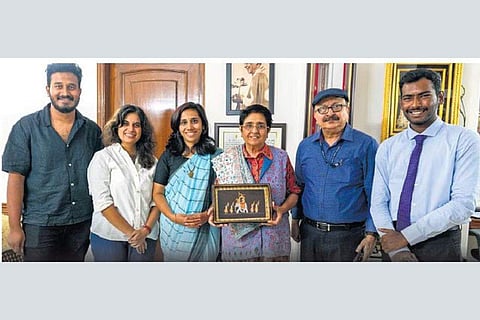
- LIFESTYLE
- FASHION
- FOOD
- ENTERTAINMENT
- EVENTS
- CULTURE
- VIDEOS
- WEB STORIES
- GALLERIES
- GADGETS
- CAR & BIKE
- SOCIETY
- TRAVEL
- NORTH EAST
- INDULGE CONNECT

Sushmita Rajendra Kaneri’s gullak has a purpose now. On August 3, for the occasion of National Handloom Day (August 7), she launched Gullakaari — a piggy bank of kaarigars — in Delhi. It is an online startup that aims to revive dying art forms of rural and tribal India. The event was attended by former IPS officer, Kiran Bedi, who launched the platform’s new handloom collection.
Gullakaari’s aims are two-fold: helping artisans to sustain themselves by practising their traditional, and more importantly, generational craft skills, and consequently, breathing a new lease of life into uniquely Indian art forms that were on the verge of fading out.
The idea of the startup struck Kaneri when she visited India’s rural areas and witnessed the richness of Indian art forms, firsthand and noticed their underutilisation. “It pained me when I heard these artisans who have such potential were thinking of moving away from their craft to choose between their livelihood and skills,” Kaneri said.
A software engineer by qualification and a social entrepreneur by passion, she used her education in technology and engineering to tackle the issue, and as a result, Gullakaari was born. Ajit, is a representative of a group of artisans that the startup aims to help. He practises Nirmal painting, a dying art form from the Nirmal district of Telangana. He has been involved in making these paintings for over 20 years, he said with pride. His family has been involved in carrying out this tradition for two generations—this is Ajit’s inheritance. However, he is vehemently against the idea of his children carrying on with the tradition. “I don’t want them to suffer as I did. I want them to get educated, get a job and have a better life,” he states.
Initially, Gullakaari used to be a donation platform that aimed to facilitate the artisan’s livelihood through the practice of these art forms. But the team behind the startup found that the majority are not aware of the cost and the effort it takes for artisans to create each product by hand.
Fatima, a sozni and aari artist from Kashmir, puts forth her views about the lack of popular awareness. “Everyone talks about banning Chinese products and promoting swadeshi products. It should be the same for handmade products too. Machine-made products are cheap and available in abundance, but handmade products offer exclusivity. An artisan works day and night on a single piece to give it its unique finesse. They need appreciation for their skills and just payment for the time they invest,” she said.
Gullakaari’s aim is to create awareness about the lives and skills of these artisans and build a contribution-driven ecosystem where people across the world can connect to uplift the artisanal communities. To that end, the goal is to double the income of the artisans who are already a part of Gullakaari, and onboard 1,000 more who are practising different art forms, by the end of the year.
But it is not all doom and gloom in the artisanal world. Mohammad belongs to a family of artisans from Kashmir who practised papier-mache art for generations. While his father and grandfather gave up the art and his siblings are employed in other jobs, he chose to revive the generational art form. “If I don’t do it, no one will take up the initiative. Change needs to begin with us,” he said.
The handloom collection of Gullakaari is available on www.gullakaari.org.